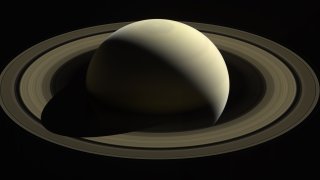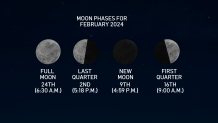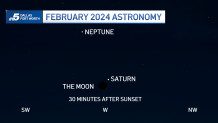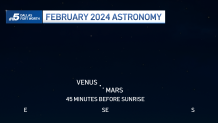
A FEBRUARY FULL MOON
On February 24th, there is a February full moon.

This full moon is called the "Snow Moon". It gets its name after snow on the ground during February. Some Native American tribes call it the "Hunger Moon" due to the scarce food sources and hard hunting conditions during mid-winter.
Get DFW local news, weather forecasts and entertainment stories to your inbox. Sign up for NBC DFW newsletters.
Other names refer to the "Bear Moon", referring to bear cubs being born this time of year. Celtic and Old English names for the February Full Moon are "Storm Moon" and "Ice Moon".
INTERESTING FACTS ABOUT FEBRUARY AND FULL MOONS
An interesting distinction of February’s Moon phases is that the month may not have any full Moon at all. Because the lunar phase cycle is 29.5 days, when there is a full Moon at the very end of January, there will be no full Moon recorded that February. This absence is often called the “Black Moon” which keeps the naming cycle synced with other months.
Weather Connection
Connecting you with your forecast and all the things that make North Texas weather unique.
The disappearance of February’s full Moon happens approximately every 19 years, most recently in 2018. The next February without a full Moon will be in 2037.
In 2048, a very rare February full Moon occurrence will happen – when the full Moon occurs on Leap Day, February 29th. The timing of this one day every four years coincides so infrequently with the lunar phase cycle that there will only be four Leap Day full Moons this millennium, with 2048 being the first. The other three Leap Day February full Moons will occur in 2132, 2216, and 2376.
MONTHLY MOON PHASES
Also, check out other phases of the moon this month.

On February 10th at 12:52 p.m. CST., the moon will be at perigee, it is closest to the Earth for this orbit at 222,506 miles. On February 25th at 8:59 a.m. CST., the moon will be at apogee, its farthest from the Earth for this orbit at 252,470 miles.
AN EVENING WITH SATURN AND NEPTUNE
Catch Saturn early in February near the Moon. Saturn reaches superior conjunction on February 28th and will reappear in the morning sky in late March.
Neptune will also be close by, but you’ll need binoculars to easily spot it.

Saturn's distance varies from the Earth. When the two are closest, they lie approximately 746 million miles apart, or eight times the distance between the Earth and the Sun.
At their most distant, when they lie on opposite sides of the Sun from one another, they are just over a billion miles apart, or 11 times the distance between the Earth and the Sun.
When Neptune and the Earth line up on the same side of the Sun, at their closest, they are only 2.7 billion miles apart. But when the planets are on opposite sides of the Sun, they can put as many as 2.9 billion miles between them.
CATCHING THE MORNINGS WITH VENUS AND MARS
If you're driving in late February, two bright objects will appear in the southeastern sky before sunrise. Guess what… it is Venus and Mars. Both planets will meet as morning stars. Catch them low on the horizon less than an hour before sunrise.

Venus's distance from the Earth varies from 24 million miles to 162 million miles. Mars averages a distance from the Earth of 140 million miles. The closest recorded distance to Mars from Earth was recorded in August 2003 when the two were 34.8 million miles apart. According to NASA, the two will not be that close again until the year 2237.
INTERNATIONAL SPACE STATION FLY-BYS
The International Space Station will make flybys across the North Texas sky this month. The ISS appears as a fast-moving star across the night sky.

The International Space Station rotates around the Earth at a speed of 17,500 mph. The ISS rotates about its center of mass at a rate of about 4 degrees per minute so that it will complete a full rotation once per orbit. This allows it to keep its belly towards the Earth. One revolution around the planet takes about 90 minutes (16 per day).
Also, the International Space Station lies at an altitude of 250 miles above the Earth. By the way, that is 1.32 million feet. Most commercial airplanes fly between 33,000 to 42,000 feet.
Please enjoy these events happening in the night sky this month. Until then...Texans, keep looking up!



